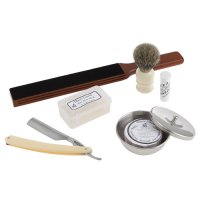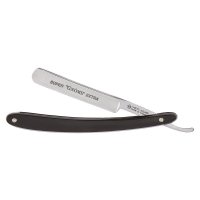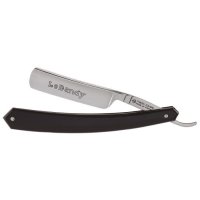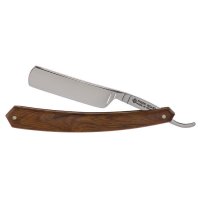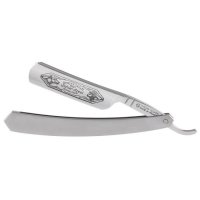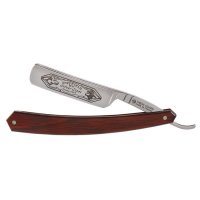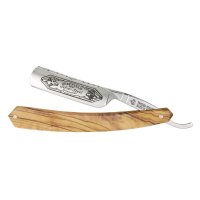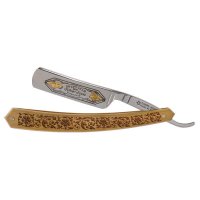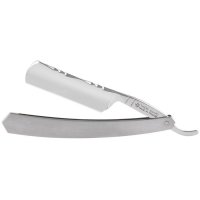Content
Expert knowledge - Razors
 Pic A: Flat Pic A: Flat (flat-ground razor) |
 Pic B: 1/2 hollow Pic B: 1/2 hollow |
 Pic C: Full hollow Pic C: Full hollow |
As you can see in the picture above, the blades actually have two hollows, between which a thin "ridge" is formed along the middle of the blade. In the picture, this ridge is shown disproportionately, but it can also be detected on the razor itself by a different reflection of the blade. The ridge increases stability and allows an even finer cutting edge.
When ground to perfection, a razor like this can "sing". You can detect a full hollow with the "nail test": When pressed on the thumbnail, the cutting edge will yield already to light pressure and then spring back fully. This means that the blade is highly elastic at the front and can thus easily follow the surface structure.

Another distinguishing feature of a full or half hollow is the stabiliser where the blade meets the tang.
A full hollow usually has a double stabiliser, which marks the transition from the blade to the tang in steps. The stabiliser protects the blade from torsional bending in the transverse direction.
A half hollow only has one stabiliser. Resistance to torsional bending is less important for half hollows because nowadays they tend to be used for narrow blades.
Blade widths are traditionally specified in inches. A 3/8 razor is a smallish razor, which is used, for example, by barbers to shave the neck or for parts of the body that are not too round.
Most razors are offered as 4/8, 5/8 and 6/8 inch, which are the best sizes for shaving. 7/8 and 8/8 inch require special experience, therefore beginners should start with 4/8- or 5/8-inch razors. In principle, the size should suit the size of the hand and the face. The 5/8- or 6/8-inch widths are the most common sizes for beard shaving and are ideal for the chin and cheeks.
The choice is yours:
Opinions often differ when it comes to sharpening - a good solution for one person may be far from perfect for another. We would like to give a general recommendation from our experience:
- For a blade needing restoration:
A blade that needs restoring should always be honed on a honing stone first. For this purpose we recommend our Shapton stones. The ceramic bond makes the stones harder than water stones and, because of the readily available grits of up to 16000, they are ideal for the fine grinding of razors. For many, this will be sharp enough, but others will want to polish the blade further with finishing pastes. Following use of an appropriate hone (or hones) to restore the correct edge geometry, we recommend successive use of bio-diamond compounds in the following grades: 6 micron, 3 micron, 1 micron and 0.25 micron. These steps are then followed by stropping on a surface with chromoxide finishing paste and then stropping of the razor on unpasted leather.
- For an out-of-the-box razor that may not yet be completely shave-ready:
For beginners, the Thiers Issard aluminiumoxide-based sharpening paste is sufficient to make a blade fit for shaving. After the paste, strop the blade without paste. For professionals, we recommend using the following in this order: Bio-diamond sharpening pastes 6 micron, 3 micron, 1 micron, 0.25 micron, chromoxide paste and finally, an unpasted strop. In addition, for regular razor care once every 2 or 3 weeks, the following sequence: Bio-diamond paste 1 micron, bio-diamond paste 0.25 micron, chromoxide paste and finally, an unpasted strop.
- For a razor already in regular use:
Before shaving, we recommend using either a strop coated with Thiers-Issard finishing paste, followed by an unpasted strop or, if you wish, an unpasted strop by itself.


